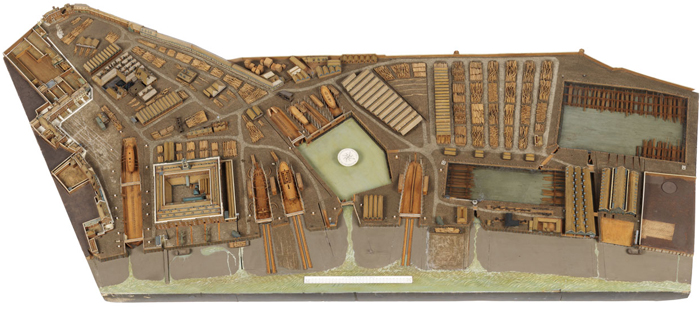 Lenox was built at the Royal Naval Dockyard at Deptford, better known as the King’s Yard. Deptford was established as a centre for naval shipbuilding by the late 15th century: the accession of Henry VIII in 1509 marked a massive programme of naval expansion, and in 1513 Henry began the development of Deptford by building a great storehouse. By the 1540s, ‘the King’s Yard’ at Deptford had become by far the most important royal dockyard in the nation for the construction and repair of warships. Sir Francis Drake was knighted here in 1581, and his Golden Hind was stored here as a visitor attraction for more than 70 years.
Lenox was built at the Royal Naval Dockyard at Deptford, better known as the King’s Yard. Deptford was established as a centre for naval shipbuilding by the late 15th century: the accession of Henry VIII in 1509 marked a massive programme of naval expansion, and in 1513 Henry began the development of Deptford by building a great storehouse. By the 1540s, ‘the King’s Yard’ at Deptford had become by far the most important royal dockyard in the nation for the construction and repair of warships. Sir Francis Drake was knighted here in 1581, and his Golden Hind was stored here as a visitor attraction for more than 70 years.
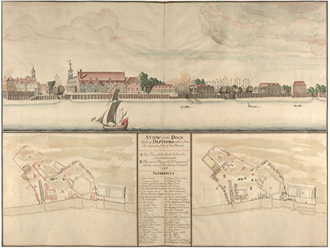 By the 17th century Deptford was the second major centre for shipbuilding after Chatham, established under Elizabeth I, gained pre-eminence in this respect; the navy board appointed a Master Shipwright in both yards. It was to Deptford that Tsar Peter the Great came for three months in 1698 to learn shipbuilding techniques, and its
By the 17th century Deptford was the second major centre for shipbuilding after Chatham, established under Elizabeth I, gained pre-eminence in this respect; the navy board appointed a Master Shipwright in both yards. It was to Deptford that Tsar Peter the Great came for three months in 1698 to learn shipbuilding techniques, and its 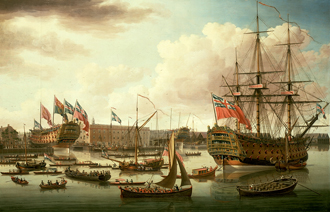 proxmity to the Navy Board Office in the City of London meant that it was frequently chosen for new or experimental construction.
proxmity to the Navy Board Office in the City of London meant that it was frequently chosen for new or experimental construction.
However, the shifting of hostilities to France and Spain in the 18th century meant that Portsmouth and Plymouth gained pre-eminence. A number of well-known vessels were fitted out at Deptford, including Captain Cook’s Endeavour and Discovery, as well as ships used in Nelson’s campaigns.
Despite navigational difficulties caused by the silting up of the Thames, and the Yard’s consequent inability to service larger ships, further expansion took place in the 18th century when the dockyard reached an area of some 30 acres, but after 1815 it fell into decline.
It closed in 1869 and the site was acquired by the Corporation of London for use as London’s Foreign Cattle Market. The handsome late 17th-century officers’ terraces, which stood to south of the Master Shipwrights House and offices, were demolished in 1902. The dockyard suffered massive destruction in WWII, and was redeveloped as warehousing known as Convoys Wharf in the 1950s, when the remains of the bomb-damaged Tudor storehouse were demolished.
The Lenox
The Restoration period saw significant developments in naval architecture and warship design. Charles II’s fleet comprised some of the most beautiful and graceful warships ever built; powerful vessels that were a unique combination of extraordinary craftsmanship and technological innovation, qualities that can be attributed to the skills of shipwrights and naval administrators of the era.
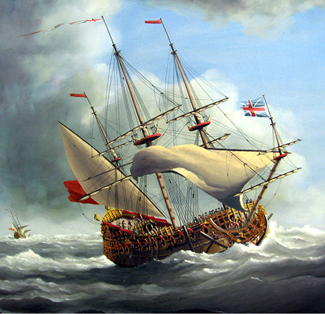 The 70-gun third-rate Lenox represented the pinnacle of Restoration shipbuilding practice. Lenox was the first of the thirty-ship programme of 1677 to be built. By 1700, these magnificent and successful vessels were responsible for the Royal Navy becoming the world’s leading maritime power.
The 70-gun third-rate Lenox represented the pinnacle of Restoration shipbuilding practice. Lenox was the first of the thirty-ship programme of 1677 to be built. By 1700, these magnificent and successful vessels were responsible for the Royal Navy becoming the world’s leading maritime power.
The lessons of the Dutch Wars, which ended in 1674, were incorporated into Lenox’s design. The third-rate, two-decker warship had already established itself as the most cost-effective vessel to fight in the recently introduced line of battle. It sailed better than the three decker first- and second-rate ships, yet it was strong enough to carry a heavy battery of guns on its lower gun deck.
Construction of Lenox started on 25th June 1677 and she was launched ten months later on 12 April 1678, a testimony to the 120 men and the Master Shipwright, John Shish, who built her. Because she was the first ship, she received an enormous amount of attention and was recorded in great detail. These include her actual dimensions, measured by Shish, the official dimension specification and the scantling list – the length, width and breadth of every individual timber.
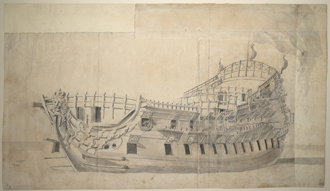 There are draughts of a sister ship and recordings of other ships lines which were drawn by Edmund Dummer while they were being built. The building list, a record of the type, quantity or number, size and cost of everything that went into her still exists, including the wages
There are draughts of a sister ship and recordings of other ships lines which were drawn by Edmund Dummer while they were being built. The building list, a record of the type, quantity or number, size and cost of everything that went into her still exists, including the wages 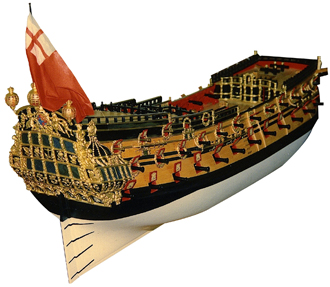 earned by all the tradesmen. Shish wrote weekly progress reports about Lenox as he built her and these also survive. Finally there is a series of architectural drawings made by the best marine draughtsman who ever lived; Willem van de Velde the Elder.
earned by all the tradesmen. Shish wrote weekly progress reports about Lenox as he built her and these also survive. Finally there is a series of architectural drawings made by the best marine draughtsman who ever lived; Willem van de Velde the Elder.
Such comprehensive source material was central to a twenty-year-long study by Richard Endsor, who recorded the complete history of Lenox in his book, Restoration Warship.
Lenox fought in two major fleet actions – the Battle of Beachy Head and Barfleur-LaHogue – and she survived until November 1699 when as a worn-out ship she returned once again to Deptford to be rebuilt.
Deptford
During the seventeenth century, Deptford was the King’s premier ship-building yard. The Master Shipwright who built Lenox was John Shish, succeeding his father, Old 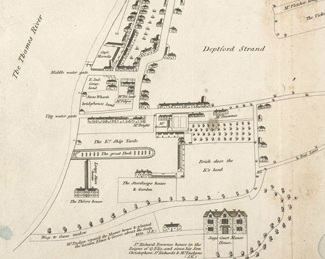 Jonas, and they are commemorated with other family members where they are buried in St Nicholas’s Church, Deptford.
Jonas, and they are commemorated with other family members where they are buried in St Nicholas’s Church, Deptford.
Most of the population of the town was also involved in building the ship, including such characters as Susanna Beckford who supplied much of the ship’s ironwork. Forthright and sometimes difficult, she more than held her own in dealing with her male colleagues.
Another was Ambrose Fellows, a 38-year-old experienced shipwright who had two apprentices. He worked on the Lenox, hewing her timbers and helping construct her in record time. His wife and children all lived in the town and on completion of the ship he was appointed her carpenter, for which a warrant was made out and signed by the King and Samuel Pepys.
Fellows stayed with the ship for nearly 20 years and such was his association, his name was first in the paybook, even before that of the captain.
These hard-working folk lived alongside Mrs Bagwell, the pretty daughter-in-law to foreman Owen Bagwell. With the connivance of her family and William, her husband, she seduced Samuel Pepys with sexual favours for the advancement of her family. Their arrangement was still going on during the time Lenox was being built.
Today, the distant successors of these colourful people of Deptford have an opportunity to recreate a small part of their history before the opportunity is lost forever under the tower blocks of modern development.
Samuel Pepys
 Samuel Pepys is famous today as a great diarist; between 1660 and 1669, while serving as Clerk of the Acts to the Navy, he poured out his innermost thoughts and actions. He wrote the diary in shorthand so that nobody, especially his wife, knew of its existence. Sharp and witty, he gained promotion, and by the time Lenox was built, had become Secretary to the Admiralty, the most important administrative position in the Navy after the King and his brother, James, Duke of York.
Samuel Pepys is famous today as a great diarist; between 1660 and 1669, while serving as Clerk of the Acts to the Navy, he poured out his innermost thoughts and actions. He wrote the diary in shorthand so that nobody, especially his wife, knew of its existence. Sharp and witty, he gained promotion, and by the time Lenox was built, had become Secretary to the Admiralty, the most important administrative position in the Navy after the King and his brother, James, Duke of York.
Pepys was also a Member of Parliament and it was through an eloquent speech that he persuaded a reluctant house to approve £600,000 to pay for construction of thirty new ships and enable the Navy to gain parity with the Dutch and French. He regarded this as the greatest achievement of his illustrious career.
Pepys certainly knew Deptford very well; he visited on business on many occasions, and even came here during the plague. Sometimes he came by boat but often walked from his home and office near Tower Hill. He often notoriously combined business with pleasure by visiting Mrs Bagwell at her home.


